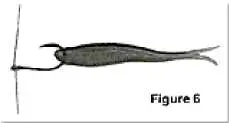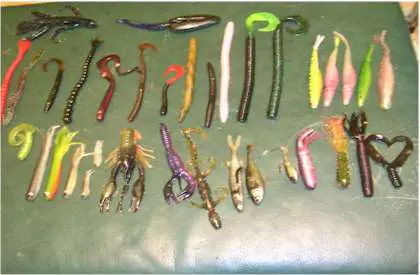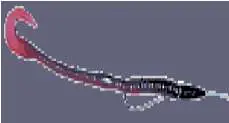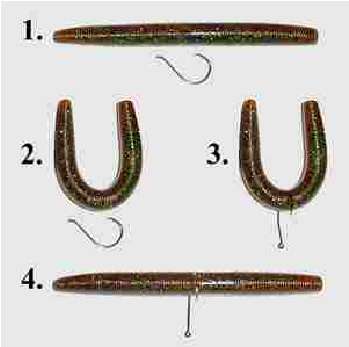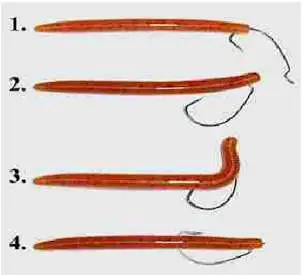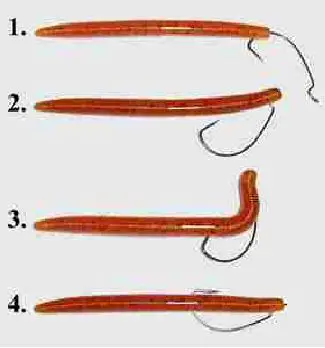Search
Latest Articles
PLASTIC BAITS AND HOW TO RIG THEM
by Bruce Middleton, August 15, 2006
Plastics are presented in six basic layouts or rigs, as they are called. The six rigs are weightless, Texas style, Carolina style, floating style, drop shot rigged, swim bait rigged, also called jerk bait rigged, and wacky style. There is a seventh rig called a split shot rig but that will discussed later. Each rig has a specific purpose and a specific way to use the rig to get the most action out of your plastic bait.
A weightless rig is just that, weightless. It has no sinkers or weights and uses the weight of the plastic as the only weight for casting. This rig is best used on spinning gear, as it is better at throwing lightweight lures than is a baitcasting reel. This rig is used with tubes, worms and creature baits and live bait, to name a few, where you want the plastic to fall as slowly as possible to keep it in the strike zone as long as possible since 75% of all strikes happen on the fall. Both floating and sinking plastics are used with this presentation. A floating rig is exactly like a weightless rig, except you use a plastic bait that floats. These baits are sometimes called swim baits because that is the way in which they are fished, with a swimming action. Swim baits or jerk bait rigs are a set up for twitching a bait on the surface or just below the surface. It has a hard crank bait counter part but soft plastics have a whole different look and action to them as apposed to a hard lure. Many different plastics are used for this presentation but fish shaped ones are the most prevalent ones used. Sinking plastics are used primarily on the bottom or mid water column where they are hopped in a stop and go retrieve or allowed to sink slowly.

A Texas rig is just about the opposite of a weightless rig. It has a sinker weight next to the plastic so that it falls to the bottom quickly or can penetrate through heavy top cover to get to the bottom. The size and shape of the sinker varies widely depending on the circumstances you are fishing in. Some angles prefer to peg the sinker in place next to or attached to the plastic while others prefer to let the sinker remain free to slide up and down the line at will. In this unpegged fashion, when a bass strikes, the sinker automatically slides up the line and does not interfere with the hook set or while your playing the fish. Also a Texas rig makes an ideal rig for skip casting your bait under docks. The other five rigs cannot make this claim. And fishing under a dock is a great place to drop a plastic bait.

A Carolina rig is like a Texas rig, except the sinker and the plastic, are separated by some distance, usually 18 inches to 3 feet. Again depending on the circumstances, floating and sinking plastics are used with a Carolina rig presentation. The main idea is to keep the sinker away from the bait so a bass does not feel it when he bites down on the bait. Sinking plastics are used when you are imitating a crawfish or other bottom dwelling forage species while a floating plastic is easier for the bass to see and strike since it is off the bottom and the bass doesn’t have to inhale a lot of mud or other debris when it strikes. A floating plastic is also quite useful in thick vegetation where the plastic can float above most of the weeds. Always use the lightest weight possible with this rig.

A drop shot rig is unique because the sinker is on the bottom and the hook is above it, which is opposite of a normal fishing set up where the hook is on the bottom and the sinker is above it. The drop shot rig is used to keep a plastic off the bottom or at a certain depth, consistently. As with all rigs the lightest weight is used so you can feel the slightest bite but not the drop shot rig. It is the only rig that uses a heavier than normal sinker. Drop shot rigs also use a much smaller hook than normal plastic rigs. Instead of a 3/0-offset hook you use a smaller hook that has a very short shank sometimes called a circle hook. A Palamar knot is used to tie the hook to the line. The hook is never tied closer than 2 feet from the sinker. This keeps the fish from confusing the sinker with the bait.
 ,/center>
,/center>A wacky rig is wacky looking when you see it for the first time and hence its name. Instead of hooking a plastic in the end like a normal bait, with a wacky rig you hook it in the middle. With a worm, for example, instead of having a nice long torpedo shape, a wacky rig gives you a "U" shaped worm with the hook exposed when it is twitched. This changes the action and the way you fish this worm. Many different plastics are used for this presentation. And it’s a good way to use those plastics that are too chewed up at the end to hook up normally. New models of wacky worms are made to be weedless and are shaped like a "Y". Don’t dismiss this rig as something to use as a last resort. This rig catches bass and a lot of them. It is a style that is seldom used and that fact alone is like introducing a new lure to a lake. Bass become accustomed to the same old lures and won’t strike them. But a simple change like this will peak their curiosity and they will strike it. Use several types of retrieves until you find the one the bass want and then stick to that one for the rest of the day. You won’t be sorry.

All six of these rigs are important to understand and use. They all catch fish and you will use them all season long. Study the pictures well to gain a full understanding of how these rigs are put together and how they will help you pull in the big ones.
Several knots are used to tie these rigs together with, a Rapala knot, a Palamar knot, a Trilene and a clinch knot being the most commonly used. There are of course many others used including the old granny knot but it like so many others they don’t have the holding strength of the first knots I mentioned. These first knots have the advantage of having 95-100% holding strength. That is to say that the knot is likely to fail just as much as any part along the length of the line. This is important, as it doesn’t reduce the test line your using from say, 14 pounds down to 12 pounds or less.
A Palamar knot is a simple to tie knot that retains 95-100% of its strength.
The twisting Clench knot is the simplest and most often tied knot by most fishermen today but it only has an 85% holding strength.
A Trilene knot is like the twisting clench knot except you add an extra loop at the beginning, so you have two loops to go through instead of one after you twist it up. This knot has 95% holding strength.
An improved clinch knot takes the knots strength from 90% to 95% with one simple move as shown. When you are done with a regular clinch knot you take the tag end and run it through the major loop instead of letting it hang loose. Sometimes it’s the small things that make a difference.
A lot of magazine articles have been written about how worms have fallen out of favor with the professional circuit. They state that no big bass tournament in years has been taken by using worms. Well that may or may not be true but worms work and they work really well during the spawn and all other seasons rigged wacky. They work in shallow water under docks and around structure and they work in grass and weeds. Maybe no big tournament has been won with a worm but you have to remember that those guys’ fish under a clock and the rest of us don’t have to power fish to make a living. We can take our time and use a worm instead of having to power fish for 5 hours and run back to the scales. When using worms you have to work them and make them look alive and so irresistible that a bass just has to eat it.
When using plastics, ALWAYS use the smallest weight possible. This is a key point to remember. What you are looking for is a natural fall to the lure, not a 1- pound thud as it crashes into the bottom.
Heavily salted worms and other plastics will sink because of the added weight of the salt. Rigged weedless, they are best cast weightless as they are quite heavy already. With this set up you will be able to cast great distances and crawl the worm along the bottom without snagging anything and without any added weight.
The best length, on average, of worms to use by season are; winter = 4 inches, spring = 5 to 6 inches, summer = 7and ½ to 12 inches and fall = 6 inches.
When it comes to rigging plastics, most beginners worry about getting the hook straight and weedless and the worm looking natural. What they don’t know is that this is only one half of it. Have you ever seen a worm with a ‘c’ shaped tail? Ever wonder exactly why that ‘C’ shape is so important and what happens if you hook it so the ‘C’ is pointed up or down or even sideways, oriented to the hook? Well it makes a HUGE difference. Hooked with the tail pointed up in relation to the hook tip is called ‘dead sticking’ and is used for fast retrieves where not a lot of water displacement or bait action is wanted. Rigged with the tail down sets up greater vibration and you get more out of the built-in action of the worm. Hooked sideways you get, not half dead stick and half action like you would think, but three quarters dead stick and one-quarter action. On straight worms with no curved tail you have to look for the ridgeline that runs down the length of the worm. Hooking through the ridge or not through the ridge changes the action also. This is true for all swim style plastic worms. Frequently check you your plastic bait to ensure that they are still hooked up weed less.
Worm fishing, depending on how they are hooked will determine the action imparted to that worm. We will now talk about all the types of worms besides ‘c’ tails. Straight worms are the workhorses of this plastic group; even then the variety within this class is huge. Scented, salted, type of action, fat, skinny, cut tail, blunt tail, floating, sinking etc. They can be hooked Texas style, Carolina style, drop shot, wacky style, weightless, weedless, etc. They can be retrieved fast, slow, using stop and go, twitched, suspended in mid water column, left on the bottom, swam on the surface and used as a second bait (a Carolina rig where the weight is replaced by a jig and the worm or other plastic is used as the bait). Now you are beginning to see how versatile a simple little worm can be. A curly tail worm drops through the water column relatively slowly, ungelating and vibrating as it sinks. It works best on the fall. Be a line watcher with this one. Ribbon tail worms are visual worms that attract attention with its swaying tail. It is a swimmer and works best on a Carolina rig. A ribbed or French Fry worm displaces a lot of water as it moves through the water sending out extra strong vibrations making very effective in heavy cover and dingy water. Carolina rig this worm. Finesse worms are usually 4 inches or less long and are for inactive fish and are moved very little. They are best used with minimal weight and weedless. Floating worms are used Texas and Carolina rigged and sometimes weightless twitched along the surface. The ability of these worms to float up and be seen is their most important feature.
Most beginners when they look at a plastic worm just see a hunk of plastic and can probably get a hook into it with out much problem. When a worm is poured at the factory it is done so in two halves and joined together. The seams that run down the sides dictate where you put the hook tip in and where you pull it out at for getting different actions. Bet you didn’t know that one. For a pitching and flipping worm with a C tail you enter the nose of the worm with the tip and exit on the proper seam (so the tail stays down) about 3/8’s of an inch down. Slide the worm up to cover the hook eye and knot. Rotate the hook and pinch the worm to reenter it. Slide the hook completely through the worm at a 45-degree angle. Tuck the hook point back into the worm to make it weed less. Swim tail worms and ribbon tails are hooked the same way, with the seam. Floating worms are hooked 90 degrees between the seams so the flat tail stays flat with respects to the hook. Tubes have no seams. Little things like seams on worms, how to hook them differently and red bleeding hooks are the results of technology, testing and engineering. A lot of testing has gone into finding the best way to hook up a worm to get the action out of it.
Carolina rigs put your bait in front of more bass in a shorter period of time than a drop shot rig. Some techniques like jigging are a bear to learn but not Carolina fishing. The beauty of it lies in its simplicity and is now the number 1 method of using soft plastics, because it’s caught more bass than any other soft plastic method. Now this statement must be qualified. It has become the number 1 method since the invention and sale of Strike King’s 3X™ brand plastics. The super soft, super flexible, super strong, anti tearing and buoyant material, that Strike King uses, has revolutionizes the fishing industry. The baits of a Carolina rig float using this product. So while the sinker may be covered with algae and weeds on the bottom, the bait is clean and floating 18 inches to 3 feet above the bottom where it can be seen. Pulled slowly along the bottom the bait dives down with each pull, only to drift back up. The rate of drift upwards is determined by the weight of the hook used. It no longer falls to the bottom and just lies there inching along as you pull it. Even Texas rigged the tail will lift off the bottom making it easier to see. And with both, the softness of this new material makes the bait come alive with the slightest movement, and wiggling and swimming, drawing attention to it. It is a perfect rig for a beginner to learn how to rig up and use. All you have to decide is what bait and what color to start with. Oh, by the way, Strike King has the widest selection of styles and colors of baits than any other manufacture. When retrieving a Carolina rig, if you keep the rod tip up you’ll hang up less often than by keeping it pointed down.
A plastic worm can catch fish better than most lures simply because even if you let it lie on the bottom or suspended in mid water for long periods of time, its still working for you.
Straight tail worms work best with a horizontal fall. A wiggle action or a wavy action along the length of the body is what makes this worm attractive to bass. Curly tail worms are general-purpose worms that are good for swimming and deep-water presentations. Ribbon tail worms are swimmers for the most part, used in shallow water but can be in a horizontal presentation. A sickle-tailed worm is a swimmer also but has a fatter body than most. A tube tail worm is a bottom bait. And finesse worms are small, straight worms noted for their lack of action. They are good in deep clear water and shallow dingy water under docks and around structure.
I hope this helps clear away a little of the fog that surrounds the subject of plastic baits and how to hook them up correctly. Since we all use plastics so much, it’s important to understand every little aspect about them from the line to the hook to the plastic itself. It may seem like a simple subject to some but it is one of the most important subjects to get right every time you use one of these rigs.

Bruce Middleton
bpmiddleton@peoplepc.com
